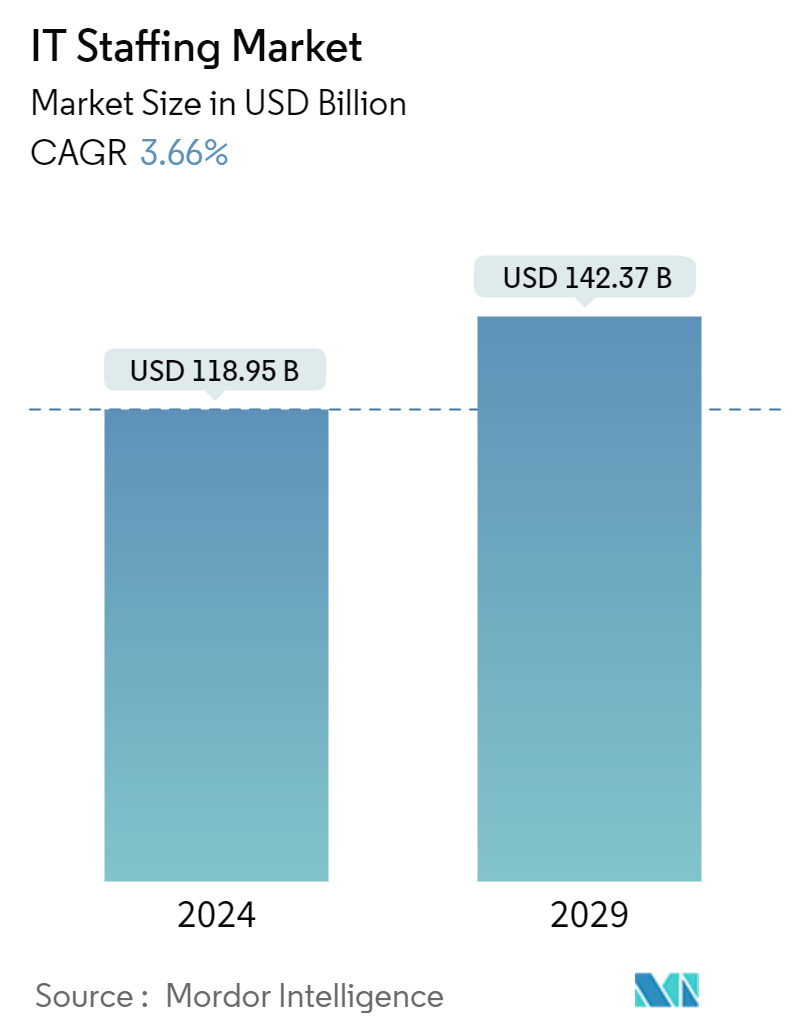Market Size of IT Staffing Industry

| Study Period | 2019 - 2029 |
| Market Size (2024) | USD 118.95 Billion |
| Market Size (2029) | USD 142.37 Billion |
| CAGR (2024 - 2029) | 3.66 % |
| Fastest Growing Market | Asia-Pacific |
| Largest Market | North America |
| Market Concentration | Low |
Major Players
*Disclaimer: Major Players sorted in no particular order |
IT Staffing Market Analysis
The IT Staffing Market size is estimated at USD 118.95 billion in 2024, and is expected to reach USD 142.37 billion by 2029, growing at a CAGR of 3.66% during the forecast period (2024-2029).
- The market's growth can be attributed to the increasing outsourcing of HR activities and the emergence of advanced technologies such as AI and advanced analytics, which are expected to create robust demand for IT professionals across multiple end-user segments.
- The growing usage of analytics solutions in recruitment is also expected to increase the need for specialized HR services. According to a recent LinkedIn report, around 92% of professionals consider analytics to be the key to recruitment in emerging economies such as India.
- HR analytics aids in improving the productivity of HR services by making predictions about crucial factors, such as performance, retention, and recruiting. These elements are all driving the market's expansion. By using HR analytics, HR departments can make data-backed decisions about managing attrition and spot areas where automation can be introduced. It can leverage the solution capabilities to capture insights on employee feedback forms.
- HR analytics can also implement AI recruiters to automate interview scheduling, provide real-time feedback to employees, and improve the handling of big data HR analytics. This will help HR executives save not only time but also money.
- Moreover, multiple firms across end-user segments are also migrating toward the cloud to continue delivering solutions to their clients and ensuring the continuity of their critical operations. According to Microsoft 365, the company witnessed a massive 775% increase in the usage of its cloud services. This is expected to create a significant spike for cloud and cybersecurity professionals.
- The growing digitization across various sectors and the increasing demand for skilled employees in the IT and telecommunication industry have augmented the growth of IT staffing worldwide. For instance, according to a Nasscom report, the Indian tech industry is set to add 60,000 jobs in the fiscal year 2023-24, bringing the total workforce to 5.43 million employees.
- Based on opportunities afforded by recent changes to the US tax code, companies are expected to expand further and accelerate their staffing efforts. Private businesses are expected to receive an average 5% increase in their bottom line. Their leaders also anticipate continuous economic growth for the next 12 months. As a result, many firms are investing their dollars in human capital. These moves coincide with the IT staffing trends.
- Staying ahead in the current dynamic business landscape hinges on a workforce equipped with the latest skills. According to the World Economic Forum, by 2029, 44% of workers will see their skills become obsolete. Corporate cultures must prioritize upskilling and reskilling efforts. By doing so, they unlock employee potential, boost job satisfaction, drive engagement, and ultimately enhance productivity and retention rates.
IT Staffing Industry Segmentation
IT staffing is a management process that includes hiring and developing IT manpower necessary to fill the various positions in the organization. IT staffing is getting increasingly outsourced to ensure better manpower for managing the organization effectively.
The IT staffing market is segmented by skill set (software developer, tester, systems analyst, technical support professionals, networking and security experts, and other skill sets), end-user industry (telecom, BFSI, healthcare, manufacturing, retail, and other end-user industries), and geography (North America, Europe, Asia-Pacific, and Rest of the World).
The market sizes and forecasts are provided in terms of value (USD) for all the above segments.
| By Skill Set | |
| Software Developer | |
| Testers | |
| Systems Analyst | |
| Technical Support Professionals | |
| Networking and Security Experts | |
| Other Skill Sets |
| By End-user Industry | |
| Telecom | |
| BFSI | |
| Healthcare | |
| Manufacturing | |
| Retail | |
| Other End-user Industries |
| Geography | |
| North America | |
| Europe | |
| Asia-Pacific | |
| Rest of the World |
IT Staffing Market Size Summary
The IT staffing market is poised for steady growth over the forecast period, driven by the increasing outsourcing of HR activities and the rise of advanced technologies like AI and IoT. These developments are creating a robust demand for IT professionals across various end-user segments. The growing use of analytics in recruitment is further amplifying the need for specialized HR services. As companies migrate to cloud solutions to maintain operational continuity, the demand for cloud and cybersecurity professionals is expected to surge. The financial services sector, being highly susceptible to cyber threats, is particularly driving the need for security experts. The ongoing digitization across sectors and the rising demand for skilled IT and telecommunications employees are contributing to the global expansion of IT staffing.
The Asia-Pacific region remains a leader in the IT service market, with significant investments in skilled resources by major companies. Initiatives like Digital India and China's strategic focus on IT innovation are expected to bolster market growth. The increased adoption of public cloud computing is prompting enterprises to reallocate business systems to cloud platforms, thereby driving staffing needs. The IT staffing market is fragmented, with key players engaging in strategic partnerships and acquisitions to maintain their market positions. Despite challenges such as the potential turnover of software developers seeking better compensation and flexible work environments, the market is set to benefit from the ongoing digital transformation and the emergence of a startup culture, which are expected to drive demand for software development skills.
IT Staffing Market Size - Table of Contents
-
1. MARKET INSIGHTS
-
1.1 Market Overview
-
1.2 Industry Attractiveness - Porter's Five Forces Analysis
-
1.2.1 Bargaining Power of Suppliers
-
1.2.2 Bargaining Power of Consumers
-
1.2.3 Threat of New Entrants
-
1.2.4 Threat of Substitute Products
-
1.2.5 Intensity of Competitive Rivalry
-
-
1.3 Assessment of the Impact of COVID-19 on the Market
-
-
2. MARKET SEGMENTATION
-
2.1 By Skill Set
-
2.1.1 Software Developer
-
2.1.2 Testers
-
2.1.3 Systems Analyst
-
2.1.4 Technical Support Professionals
-
2.1.5 Networking and Security Experts
-
2.1.6 Other Skill Sets
-
-
2.2 By End-user Industry
-
2.2.1 Telecom
-
2.2.2 BFSI
-
2.2.3 Healthcare
-
2.2.4 Manufacturing
-
2.2.5 Retail
-
2.2.6 Other End-user Industries
-
-
2.3 Geography
-
2.3.1 North America
-
2.3.2 Europe
-
2.3.3 Asia-Pacific
-
2.3.4 Rest of the World
-
-
IT Staffing Market Size FAQs
How big is the IT Staffing Market?
The IT Staffing Market size is expected to reach USD 118.95 billion in 2024 and grow at a CAGR of 3.66% to reach USD 142.37 billion by 2029.
What is the current IT Staffing Market size?
In 2024, the IT Staffing Market size is expected to reach USD 118.95 billion.

